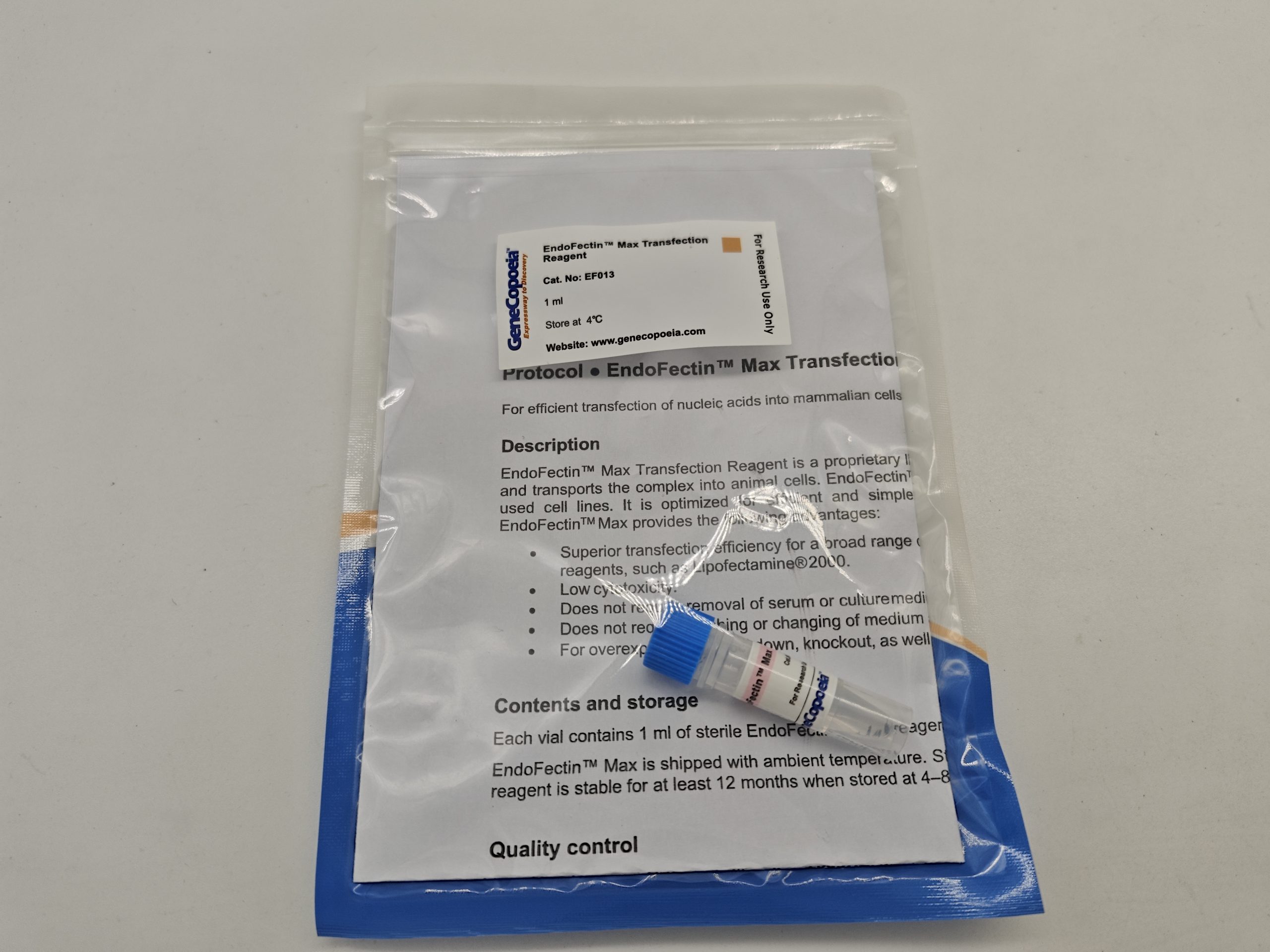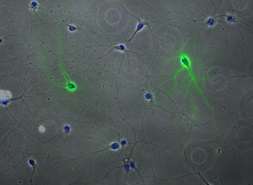A versatile & efficient suite of robust transfection reagents
GeneCopoeia’s EndoFectin™ line of transfection reagents provide affordable and powerful solutions that encompass a range of different applications, general purpose reagents like EndoFectin™ Max. See below to learn more about.
Products

EndoFectin™ Max Transfection Reagent
EndoFectin™ Max is a lipid-based transfection reagent. This versatile transfection reagent has been tested and optimized for highly efficient transfection of a large collection of commonly used cell lines as well as many difficult-to-transfect cell lines.Advantages
- Equal transfection efficiency for several cell lines compared with Lipofectamine® 3000 in plasmid transfection (Figure 1).
- Superior transfection efficiency for a broad range of cell lines compared with Lipofectamine® 2000 (Figures 2 and 3).
- Equal to or greater transfection efficiency compared with Lipofectamine® 2000 in siRNA transfection (Figure 4).
- Low cytotoxicity (Figure 5).
- Does not require removal of serum or culture medium, or removal of medium after transfection.
- For overexpression, knockdown, knockout, as well as high-throughput applications
Experiment 1: Comparison of EndoFectin™ Max and Lipofectamine® 3000 in plasmid transfection
| A | B | ||
| C | D | ||
| E | F | ||
|
Figure 1. Transfection of 6 commonly-used cell lines using either EndoFectin™ Max, Lipofectamine® 2000 (LP2000) or Lipofectamine® 3000 (LP3000). Cell lines were transfected with a firefly luciferase-expressing plasmid. Transfection efficiencies were assessed by luciferase activity (RLU). Note: for HEK293 (A), HeLa (C), A549 (D), H1299 (E), and 1321N1 (F), 0.15 uL/well of Lipofectamine® 3000 was used rather than 0.2 uL/well. Lipofectamine® is a trademark of Invitrogen. |
|||
Experiment 2: Comparison of EndoFectin™ Max and Lipofectamine® 2000 in plasmid transfection
| A | 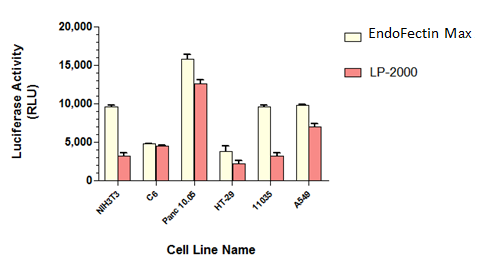 |
| B | 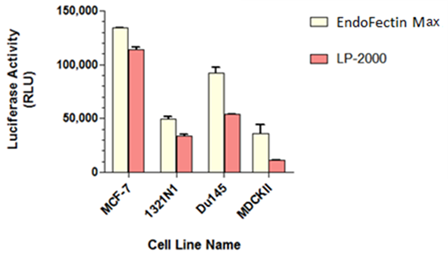 |
| C | 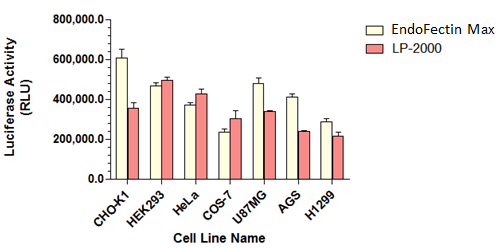 |
| Figure 2. Transfection of 17 commonly-used cell lines using either EndoFectin™ Max or Lipofectamine® 2000 (LP-2000). Cell lines with low transfection efficiency (A), medium transfection efficiency (B), and high transfection efficiency (C) were transfected with a firefly luciferase-expressing plasmid. Transfection efficiencies were assessed by luciferase activity (RLU). Lipofectamine® is a trademark of Invitrogen. | |
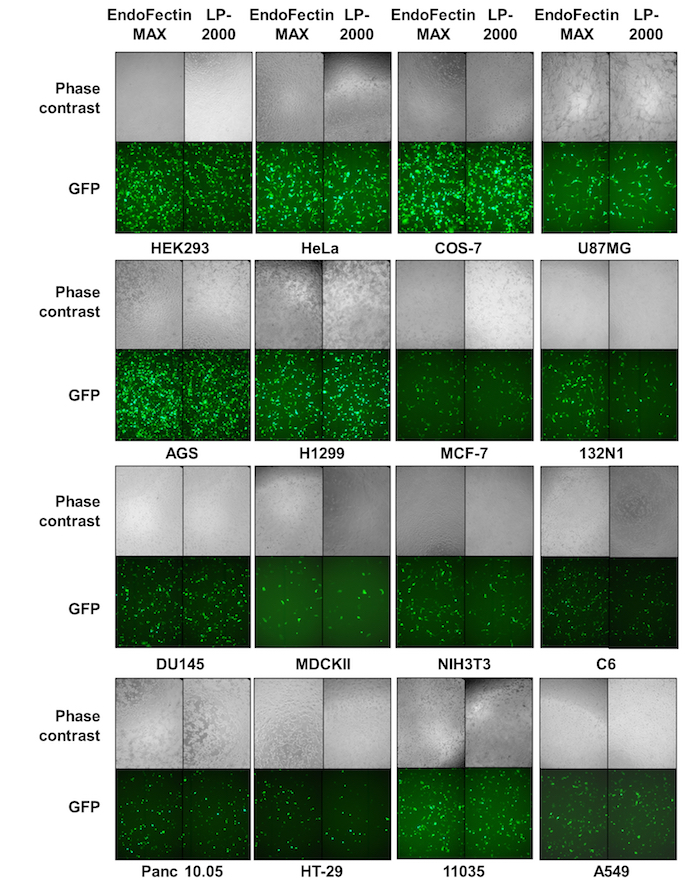 |
| Figure 3. Assessment of EndoFectin™ Max transfection efficiencies using GFP visualization. 16 commonly-used cell lines were transfected with a GFP-expressing plasmid using either EndoFectin™ Max or Lipofectamine® 2000 (LP-2000). Cells were visualized 48 hours post-transfection under phase contrast or fluorescence microscopy (GFP filter). Lipofectamine® is a trademark of Invitrogen. |
Experiment 3: Comparison of EndoFectin™ Max and Lipofectamine® 2000 in siRNA transfection
| A | B |

Figure 4. Comparison of transfection of siRNA between EndoFectin™ Max and Lipofectamine® 2000, Cell lines H1299 (A) and HEK293 (B) were transfected with either a firefly luciferase-expressing plasmid (blue bars), or co-tranfected with a firefly luciferase-expressing plasmid and an anti-luciferase siRNA (red bars). Transfection efficiencies were assessed by luciferase activity (RLU). Lipofectamine® is a trademark of Invitrogen.
Experiment 4: Comparison of EndoFectin™ Max and Lipofectamine® 2000 for cytotoxicity
 |
| Figure 5. Comparison of cytotoxicity between EndoFectin™ Max and Lipofectamine® 2000. Lipofectamine® is a trademark of Invitrogen. |

